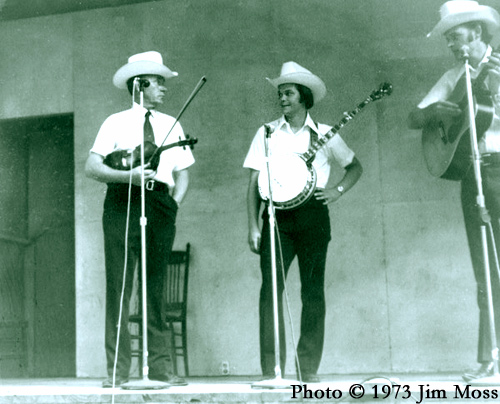
Bluegrass Boys, Bean Blossom 1973
Waiting for Monroe.
Monroe over slept and was late for this show.
Left to Right: Kenny Baker, Jack Hicks, Bob Fowler
Photo by Jim Moss
 |
|
Bluegrass Boys, Bean Blossom 1973 Waiting for Monroe. Monroe over slept and was late for this show. Left to Right: Kenny Baker, Jack Hicks, Bob Fowler Photo by Jim Moss |
Jack Hicks Now and Then.
Chromatic Banjo in The Bluegrass Boys (1971 to 1973)
As you read this understand that Jack Hicks is a real nice person as well as
super polite in a southern way. He is from, and lives in Kentucky. He is a man of few words.
To me he sounds just as he did when he was a teenager in the Bluegrass Boys.
He is a very impressive banjo player though and one that just took down the house
when I saw him in Marin, California back in 1973. In his few words approach it sometimes
takes a few exchanges to understand what he is talking about, such as when he described his studio roof.
This was fun to do and I think it will be fun to read. Jim Moss 4-14-2008
![]()
A extended interview with Jack Hicks
conducted by Jim Moss 3-19-08.
![]()
NOTE: If
permission to reprint this is granted by owner, each part must presented
in its entirety with the "by line" and URL
"www.candlewater.com"
Jim Moss: Do you have a web site or somewhere that people can see
what you are doing?
Jack Hicks: Well, what I am doing now... I am picking some for Melvin Goins.
And I am helping Jesse McReynolds some and... working the Opry and things
like that. And I am running a recording studio.
Jim Moss: Well, that's good. Tell me about your recording studio.
Jack Hicks: Well, I built... I took a motor home, like a big class A motor home?
And gutted it... and built a mobile studio in it.
Jim Moss: Uh huh. You know I have a recording studio here.
Jack Hicks: That's right, yeah.
Jim Moss: What kind of equipment do you have?
Jack Hicks: I use a Mac you know...
Jim Moss: Are you using ProTools?
Jack Hicks: I'm using Cubase... Video 4... and uh...
Jim Moss: I see, that's great. So it is a PC based system, so you mix on your PC.
I have trouble using or mixing in this environment, looking at 32 channels on a
computer monitor, but they have some real nice very large LCD monitors out now
and that does make a big difference.
Jack Hicks: I use these Mackie Control Surfaces? So I just use the extenders,
I can... makes it just like mixing off a board.
Jim Moss: And if you have a big monitor...
Jack Hicks: I do...
Jim Moss: It makes it easier to see.
Jack Hicks: Right, you can spread it out. It works pretty good.
Jim Moss: So, when you make a recording, Melvin said you were making a
album. So, what rooms do you record them in?
Jack Hicks: Well, I built rooms in the studio... in the motor home.
Jim Moss: In the motor home...
Jack Hicks: Right. I gutted it and I built the control room then I build two other rooms
back through it.
Jim Moss: Are you in one of those rooms right now?
Jack Hicks: No.
Jim Moss: It sounds like a lot of echo. Your in the kitchen right?
Jack Hicks: (laughs) Yeah! That's where I'm at, you know, I am in the kitchen. (more laughs)
Jim Moss: So that's great. Do you have pretty good mics?
Jack Hicks: Yeah yeah.. pretty fair.
Jim Moss: And you have good isolation?
Jack Hicks: Yeah, I even took the roof off of it.
Jim Moss: The roof! You took the roof off of it! Wow...!
Jack Hicks: Yeah.
Jim Moss: What do you mean the roof? The sky is up there?
Jack Hicks: Yeah... I took the whole roof off.
Jim Moss: So how do you keep the rain out? ...and the birds...?
Jack Hicks: I mean... that's what I did, I took the roof off and rebuilt it.
Jim Moss: oooh, I see! uh huh. Sure sure.... Yeah, it's quite a job.
Jack Hicks: Oh it was. It was a huge undertaking. The beauty of it is... I can...
Like if somebody wants to record? I can pull up to their house and
plug into 110 (volts) outside and get the same sound that I can here at the home.
Jim Moss: uh huh... course, the rooms are moving with you.
...More on Banjo
Jim Moss: Now... the first time I saw you playing, was out here in California with the
Bluegrass Boys. You had just come down from Humboldt, and you were playing in
Marin County, just above San Francisco.
Jack Hicks: Oh yeah?
Jim Moss: Yeah. You had this great bluesy sound, you were playing with Monroe...
Then I went back to Bean Blossom in 1973, I hitch hiked back there... and the first morning
I woke up, it was a little wet out having just rained... I was sleeping in my sleeping bag
when someone tapped on my sleeping bag. I looked out to see you!
Jack Hicks: (laughs)
Jim Moss: You wanted...
Jack Hicks: I was collecting money.
Jim Moss: Yeah, you wanted money for the ticket.
Jack Hicks: Yeah, we used to do everything. We used to go up
weeks before Bean Blossom and clear land... Did everything in the world.
Jim Moss: Yeah, I understand Baker was involved in that too. Didn't you guys
build the old outdoor stage?
Jack Hicks: I was in part of it, yeah.
Jim Moss: I liked that little stage, you know!
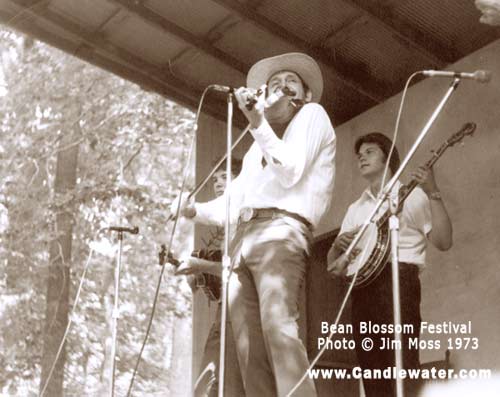 |
|
Bluegrass Boys, Bean Blossom 1973 Tex Logan & Jack Hicks on the old stage. Photo by Jim Moss |
Jack Hicks: And then all that land back over where the stage was...
back up in through there, we cleared all of it... you know, with horses and such.
Jim Moss: You talking about in front of the stage... where the seats where?
Jack Hicks: Yeah, in front of it. And all up through there where they had the
camping and stuff. Up through there.
Jim Moss: Where the clearing for the power lines were?
Jack Hicks: Yeah, we cleared all of that.
Jim Moss: You know if you go back there today it is hard to see where all that was.
Jack Hicks: Oh it is!
Jim Moss: So, when did you start playing banjo?
Jack Hicks: I was uh... I can't remember I have done it so long. (laughs)
Jim Moss: What inspired you to play the banjo?
Jack Hicks: Oh, my dad. Yeah he played.
Jim Moss: I think I met your mother there.
Jack Hicks: Probably so. They were there for years and years. Bill (Monroe) gave
them a free pass to Bean Blossom for as long as they lived.
Jim Moss: Right, just like Jim Peva.
Jack Hicks: Right.
Jim Moss: So your dad played banjo. Did he follow just a Scruggs style?
Jack Hicks: Oh yeah, definitely.
Jim Moss: Scruggs was really great.
Jack Hicks: Oh yeah.
Jim Moss: It seemed that Bill had a lot of innovators. The stuff that you
came out with was, I thought, was an innovation at the time, was a more
bluesy sound. Also that you were doing it in the Bluegrass Boys!
So you started out... you must have been sixteen when you were in that band.
Jack Hicks: I was seventeen.
Jim Moss: So you must have been about 10 when you started playing...
Jack Hicks: I'd say I was about... I think I was fourteen or fifteen... I used to
go up to... I used to play a club up in Columbus Ohio... on the weekends...
with Wayne Lewis. I used to play up there with him. It was called the Astro Inn.
Jim Moss: So how did you get asked to play with Monroe?
Jack Hicks: Well... You know we went to Bean Blossom for years. I think we
started going the second one. And.. I just got to know him through that you know.
Jim Moss: So when did you start moving away from Scruggs style?
Jack Hicks: When I was young. It wasn't long after I first started playing I started
varying off. I'll tell you... Eddie Adcock was one of my heroes. He really was, I mean.
He was just way good to me... and still is. I still think a world of him. He taught me
so much it was unreal.
Jim Moss: And he was playing that bluesy chromatic stuff?
Jack Hicks: No he wasn't playing that, but you know... He just taught me to play
whatever I wanted to. (laughs) you know... And then when I got with Bill, Bill let me.
He let me play whatever.
Jim Moss: When I talked with you ten years ago, you said that you actually played
what Bill wanted you to play. How much influence did Bill have on you?
Jack Hicks: He had a lot. He really had a lot on me.
Jim Moss: As far as the bluesy chromatic notes?
Jack Hicks: Well, what he did was he allowed me to play it.
Like "You Won't Be Satisfied That Way" and stuff like that. He encouraged me to
do whatever... to get out there on that limb. Sometimes I would chop it off, but... (laughs)
He'd let me go for whatever.
Jim Moss: I can hear that in the tapes of the shows that you did when you
first started with the band and how you progressed as you got to the point
when you actually left the band.
You left in 1973 right? And you went off to play with the White Family.
I remember one afternoon show where you were late getting to the stage for Monroe
you were involved with a jam with Joe Stuart and Paul Mullins. (photo below)
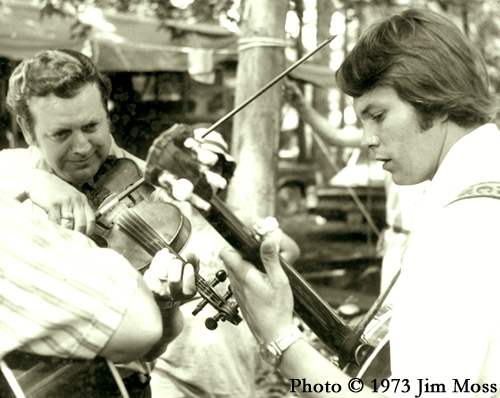 |
|
Bluegrass Boys, Bean Blossom 1973 Left to Right: Joe Stuart's Arm, Paul Mullins, Jack Hicks Photo by Jim Moss |
So, when you look at your playing next to Kenny Baker's...
Baker was able to be much more fluid with your chromatic runs that you do, those
runs would really fit the feel of and gave feedback to what Baker was playing.
You both were taking these long note runs in your playing of backup up and
solo breaks behind vocals. It was very fluid sounding. I talked to Baker about that
after you left and he said "Yeah, that's exactly right".
How did you think about the fit of the timing to Monroe's sound back then.
Do you play that way now?
Jack Hicks: I... play some... you know... I still play some.
Jim Moss: Do you not like that style anymore?
Jack Hicks: Oh Yeah, I like it, Great... yeah!
Jim Moss: How do you approach rhythm... timing...
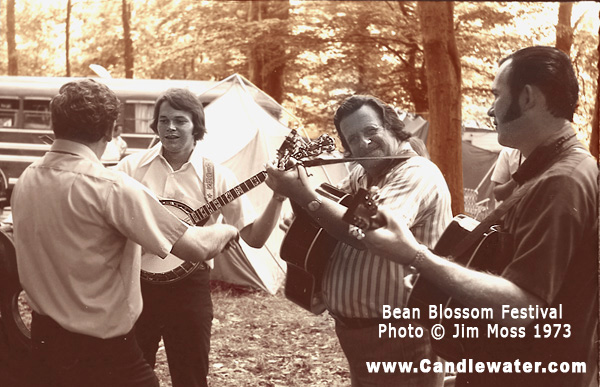 |
|
Bluegrass Boys, Bean Blossom 1973 Photo by Jim Moss |
Jack Hicks: Well back then I keyed off of Bill's mandolin. Now-a-days I play
so much in the studio... you know... I am just use to playing with a click track.
Jim Moss: I am trying to get at how you thought about your timing, how you made
your playing fit, with it's timing, into Bill's timing. You know I managed Frank Wakefield
for ten years... And a lot of musicians had trouble staying synchronized with the band
at first. They didn't understand that to play tight with Frank's playing you had to think
like a drummer. Not One and Two and Three and Four,
but One-E-And-Uh, Two-E-And-Uh, Three-E-And-Uh, Four-E-And-Uh, like a drummer
counts timing. Frank would be hitting on all of those points in one way or another and
to not drift we had to think this way. Frank would be playing counter rhythms where
you might expect a chomp, but also in his breaks were we had to present a strong
rhythm under him so he could stretch out. If that rhythm fell apart there would be problems.
How did you hear the timing that allowed you to play these long chromatic note strings?
Did you ever think like that... at all...
Jack Hicks: I don't really know. (both laugh out loud) I just kind-a...
To me timing is it! You know what I mean? That's were it's at!
I'll tell you what... without a good mandolin player it's hard.
It's hard for me... Cause I got use to that chop with Bill.
And I keyed off of it ever since. When I play a banjo I look to that.
Jim Moss: What other instruments do you play?
Jack Hicks: I play a little bit of a lot of things, but... get by...
Jim Moss: Because you were touring with a country band for awhile.
Jack Hicks: Yeah, I played fiddle with Conway Twitty for about 10 years.
And I played steel guitar with Sonny James.
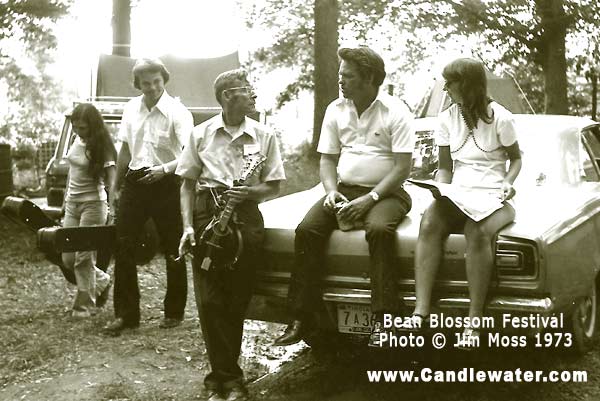 |
|
Bluegrass Boys, Bean Blossom 1973 Photo by Jim Moss |
Jim Moss: You played fiddle? Electric or acoustic?
Jack Hicks: Well, it was an old Amadi copy you know...
Well, Baker give me it. Kenny... I put a Barcus Berry pickup on it... On the bridge.
Jim Moss: The banjo was your first instrument then?
Jack Hicks: Well, actually I played guitar before I did the banjo.
Jim Moss: Rhythm guitar?
Jack Hicks: Yeah. And then like three finger style.
Jim Moss: So that is were you got your rolls from.
Jack Hicks: Yeah, I got use to using my right hand.
Jim Moss: So you changed your finger board on your current banjo.
What is the normal scale on a banjo neck? How many inches?
Jack Hicks: Uh... twenty six and a quarter.
Jim Moss: And the one you have now?
Jack Hicks: Twenty five and a half. What we used for a finger board on
my banjo... is a blank for a Fender Telecaster.
Jim Moss: Really, so it is really wide?
Jack Hicks: Well, we narrowed it up. but that scale and the curve...
the whole nine yards. Its off of a Telecaster.
Jim Moss: So your playing a shorter scale... would that mean your strings
are looser or tenser?
Jack Hicks: A little bit looser.
Jim Moss: You had an ODE. What was the deal with the ODEs back then.
Jack Hicks: Well, basically I think they just come along and gave a bunch of people banjos.
So everybody played them.
Jim Moss: I see... But they had a different ring to them. They were not as bright or percussive
as a Mastertone.
Jack Hicks: Yeah, a different sound.
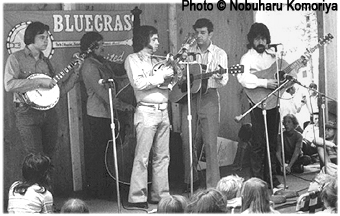
Jim
Moss: I didn't know that you had played in a band with Clarence White.
How many shows did you play in this band?
Jack Hicks: I just did a few shows with him. I was still working with Bill at the time.
Jim Moss: Well great. It was good to talk to you again.
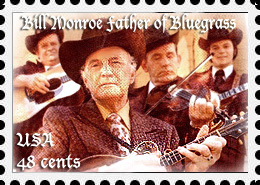
Click Here To Return To
Bluegrass Menu Page
CLICK
HERE TO: Return To The INTERVIEW Listings
![]()
Newsletter Opt-In Email (Click Here)
![]()
| All Rights Owned by Mossware LLC. Any use of these materials must be approved of in advance and in writing. |